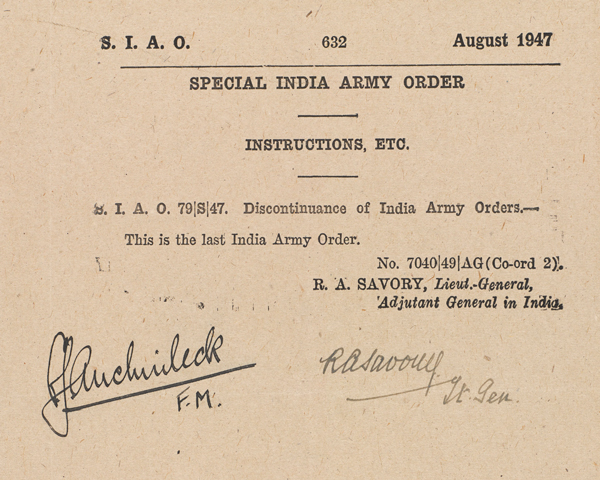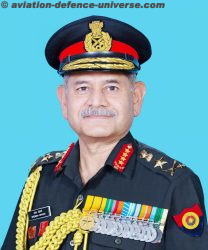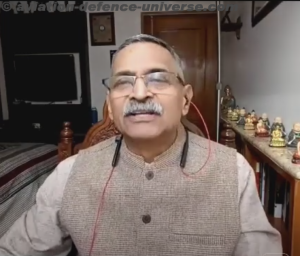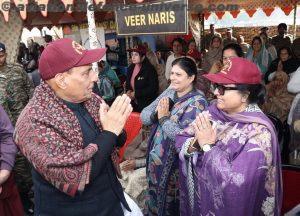
New Delhi. 08 January 2025. Pangs of partition were felt by Indian Army also and not just the nation it secured. The end of British rule in India also saw the end of the existing Indian Army and its administration. Field Marshal Sir Claude Auchinleck oversaw the division of this force. Partition was not only a huge cost to the Indian defence establishment due a division of the armed forces in which one-third went to Pakistan and two-thirds to the Union of India but also an emotional cost of division of troops from same formations into two different nation’s soldiers .
Around 260,000 men, mainly Hindus and Sikhs, went to India. And 140,000 men, mainly Muslims, went to Pakistan. The Brigade of Gurkhas, recruited in Nepal, was split between India and Britain. Many British officers stayed on to assist in the transition, including General Sir Robert Lockhart, India’s first Chief of Army Staff, and General Sir Frank Messervy, who became Pakistan’s first Chief of Army Staff. Individual units were split up. The 19th Lancers in Pakistan exchanged their Jat and Sikh troops for Muslims from Skinner’s Horse in India.
The armed forces personnel also saw division of regiments and units on nationality basis. Such a division and re-organization of the armed forces needed a co-ordinating authority, which was provided by the Supreme Commander’s Headquarters. Field-Marshal Sir Claude Auchinleok, former Commander-in-Chief, was appointed as Supreme Commander with the specific purpose of reconstituting the armed forces for the two Dominions under the directional control of the Joint Defence Council, which consisted of representatives from both Dominions, the Governor-General of India, Earl Mountbatten being the independent chairman.
The British Indian Army was divided into four Commands Northern, Southern , Eastern and Central Command. The fourth was raised during the war and disbanded in September, 1946. 15 August, 1947, the army was divided into Indian Army and Pakistan Army. Northern Command was allotted to Pakistan and the Southern and Eastern Commands were allotted to the Indian Army. A new Command, Delhi and East Punjab Command, was raised on 15 September 1947.
While the years of the Second World War had seen a heavy participation of the Indian Army Divisions the end saw the disbanding of a lot of them. 6th, 8th, 10th, 14th, 17th, 19th, 20th, 23rd, 25th, 26th and 39th were disbanded, those remaining being the 4th, 5th, 7th Infantry Divisions, 1st Armoured Division and the 2nd Airborne Division.
Predominantly Muslim units went to Pakistan, followed later by individual transfers. Close to two-thirds of all army personnel went to India. As a secular state, India accepted all armed forces personnel without regard to religious affiliation. The division of the navy was based on an estimation of each nation’s maritime needs. A combination of religious affiliation and military need was applied to the small air force. As a result of partition, India also received about two-thirds of the matériel and stores. This aspect of the division of assets was complicated by the fact that all sixteen ordnance factories were located in India. India was allowed to retain them with the proviso that it would make a lump sum payment to Pakistan to enable it to develop its own defense production infrastructure.
Following independence, British Army regiments were gradually withdrawn from the subcontinent. This included a well-planned and orderly withdrawal from Waziristan and other tribal regions of the North-West Frontier. The last unit to leave India was the 1st Battalion, Somerset Light Infantry (Prince Albert’s), which embarked at Bombay on 28 February 1948.
Infantry regiments of the Indian Army at the time of partition were Gorkha Rifles, Punjab Regiment, Sikh Light Infantry, Maratha Light Infantry, Rajputana Rifles, Jat Regiment, Kumaon Regiment, Garhwal Rifles, Madras Regiment, Dogra Regiment, Jammu & Kashmir Rifles.
The first Indian airborne formation was the British Indian Army‘s 50th Parachute Brigade raised on 29 October 1941, consisting of 151 Parachute Battalion (consisting of British troops), 152 Parachute Battalion (consisting of Indian troops) and 153 Parachute Battalion (consisting of Gurkha troops) alongside other support units. After independence and partition, the airborne division was divided between the armies of India and newly formed Pakistan, with India retaining the Divisional HQ and the 50th and 77th Parachute Brigades, while the 14th Parachute Brigade went to Pakistan. The 77th Parachute Brigade was later disbanded. Thus, the Indian Army retained only one airborne formation, the 50th Parachute Brigade. This brigade consisted of three distinguished battalions from different regiments: the 1st battalion, Punjab Regiment (Para), the 3rd battalion, Maratha Light Infantry (Para), and the 1st battalion, Kumaon Regiment (Para). These battalions had been carrying out parachute duties after the disbandment of the regiment in 1945, and had continued to wear the uniform of their parent regiments except for a change in headgear to the maroon beret, and in order to distinguish them from the other battalions of their regiments, the word ‘Para’ was added after their names.
Indian Army got in addition 12 armoured formations, 10 artillery regiments, 61 sapper units along with 400,000 men and 7,000 officers after the partition of the armed forces.
The Pakistan army, numbering 200,000 men and 4,000 officers, will include 6 armoured formations, 5 artillery regiments and 34 sapper units.































































































































